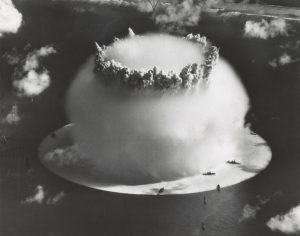Archive for the ‘Nuclear-Radiation-Contamination’ Category
March 28, 1979, the worst accident in the history of the U.S. nuclear power industry begins when a pressure valve in the Unit-2 reactor at Three Mile Island fails to close and the core began to dangerously overheat.
Thursday, March 28th, 20193/9/1981: A nuclear accident at a Japan Atomic Power Company plant in Tsuruga, Japan, exposes 59 workers to radiation.
Saturday, March 9th, 2019“…..On March 9, a worker forgot to shut a critical valve, causing a radioactive sludge tank to overflow. Fifty-six workers were sent in to mop up the radioactive sludge before the leak could escape the disposal building, but the plan was not successful and 16 tons of waste spilled into Wakasa Bay……”
Social Media Reactions to an Errant Warning of a Ballistic Missile Threat
Friday, February 22nd, 2019Murthy BP, Krishna N, Jones T, Wolkin A, Avchen RN, Vagi SJ. Public Health Emergency Risk Communication and Social Media Reactions to an Errant Warning of a Ballistic Missile Threat — Hawaii, January 2018. MMWR Morb Mortal Wkly Rep 2019;68:174–176. DOI: http://dx.doi.org/10.15585/mmwr.mm6807a2.
“……A total of 127,125 tweets were identified; after excluding 69,151 (54%) retweets and 43,444 (34%) quote tweets, 14,530 (11%) initial tweets remained for analysis. Among these, 5,880 (40%) were sent during the early period, and 8,650 (60%) were sent during the late period……”
* 8:07–8:45 a.m. Hawaii Standard Time.
† 8:46–9:24 a.m. Hawaii Standard Time (additional themes identified in addition to those in the early period).
What is already known about this topic?
Social media platforms are widely used to share information and disseminate alerts and warnings.
What is added by this report?
After an errant ballistic missile alert, social media reactions revealed how the public interprets, shares, and responds to information during an evolving threat. This knowledge can guide emergency risk communicators to develop timely and effective social media messages than can protect lives.
What are the implications for public health practice?
Social media can be an effective tool to send urgent messages during a public health emergency. Public health practitioners need to improve messaging during emergency risk communications to address the public’s needs during each phase of an unfolding crisis to protect and save lives
Pediatric considerations in radiological emergencies: new recommendations
Sunday, December 23rd, 2018The reports, Pediatric Considerations Before, During, and After Radiological/Nuclear Emergencies, are available at
http://pediatrics.aappublications.org/content/early/2018/11/21/peds.2018-3000 and
http://pediatrics.aappublications.org/content/early/2018/11/21/peds.2018-3001
and will be published in the December issue of Pediatrics.
9/30/1999: One person was killed, 49 were injured and thousands of others were forcibly confined to their homes for several days when radiation leaked from Japan’s Tokaimura nuclear plant
Sunday, September 30th, 2018“…..On September 30, workers were mixing liquid uranium when they made a serious, and inexplicable, mistake. Instead of pouring five pounds of powdered uranium into nitric acid, the workers poured 35 pounds, seven times too much. The resulting chain reaction caused gamma rays and stray neutrons to flood the purification chamber, where the radioactive water was treated…..”
9/18/1987: Cesium-137 is removed from an abandoned cancer-therapy machine in Goiana, Brazil and hundreds of people were eventually poisoned by radiation from the substance
Wednesday, September 19th, 2018US is considering scenarios where a nuclear bomb, a cyberattack, a coordinated electromagnetic pulse, and biological weapons all hit the US at the same time.
Monday, August 27th, 2018“…..“We are looking at 100 kiloton to 1,000 kiloton detonations” ………”
Exploring Medical and Public Health Preparedness for a Nuclear Incident: A Workshop
| When: | August 22, 2018 – August 23, 2018 (8:00 AM Eastern) |
|---|---|
| Where: | National Academy of Sciences Building (Fred Kavli Auditorium) • 2101 Constitution Avenue, NW, Washington, DC 20418 |
|
|
|
| Topics | Biomedical and Health Research, Public Health, Health Security |
| Activity: | Forum on Medical and Public Health Preparedness for Disasters and Emergencies |
| Board: | Board on Health Sciences Policy |
The National Academies of Sciences, Engineering, and Medicine will host a two-day public workshop on August 22-23, 2018 at the National Academies Building (Fred Kavli Auditorium) called Exploring Medical and Public Health Preparedness for a Nuclear Incident. Through this workshop, participants from government, NGO and private sector organizations will explore current assumptions behind and the status of medical and public health preparedness for a nuclear incident, examine potential changes in assumptions and approach, and discuss challenges and opportunities for capacity building in the current threat environment.
Specific topics that may be discussed in this workshop include:
- The current state of medical and public health preparedness for a nuclear incident and how these relate to the prior assumptions about the threat environment;
- Possible changes to planning assumptions for nuclear incidents, with particular attention to the (re-)emergence of state-actor threats, and the implications of those changes for nuclear incident prevention, planning and response;
- Implications for capacity building of potential communication, education and information challenges posed by a nuclear incident, and opportunities and approaches for addressing them;
- Challenges, opportunities, and implications for building capabilities to respond to and recover from a nuclear incident, including building capability for assessment, early treatment, monitoring and long-term health surveillance among survivors.
Hidden Sealed Radioactive Source (Radiological Exposure Device) in Train Car – Illustration
Sunday, August 5th, 2018
150 Ci Iridium-192 Source Under Seat
Ci = Curie; R = Roentgen; Γ constant = 4.69 R-cm2/mCi-hr.
Note: This graphic describes radiation exposure rate (in air) in units of R/Hr. For gamma radiation, this is roughly equivalent to a radiation absorbed dose rate in units of cGy/hour, which must also take into account any shielding present, e.g., material in the seats in this example.
REMM: External Contamination: Wound Contamination with Radioactive Shrapnel – Animation
Saturday, August 4th, 2018
External Contamination: Wound Contamination with Radioactive Shrapnel – Animation
Contamination
|


